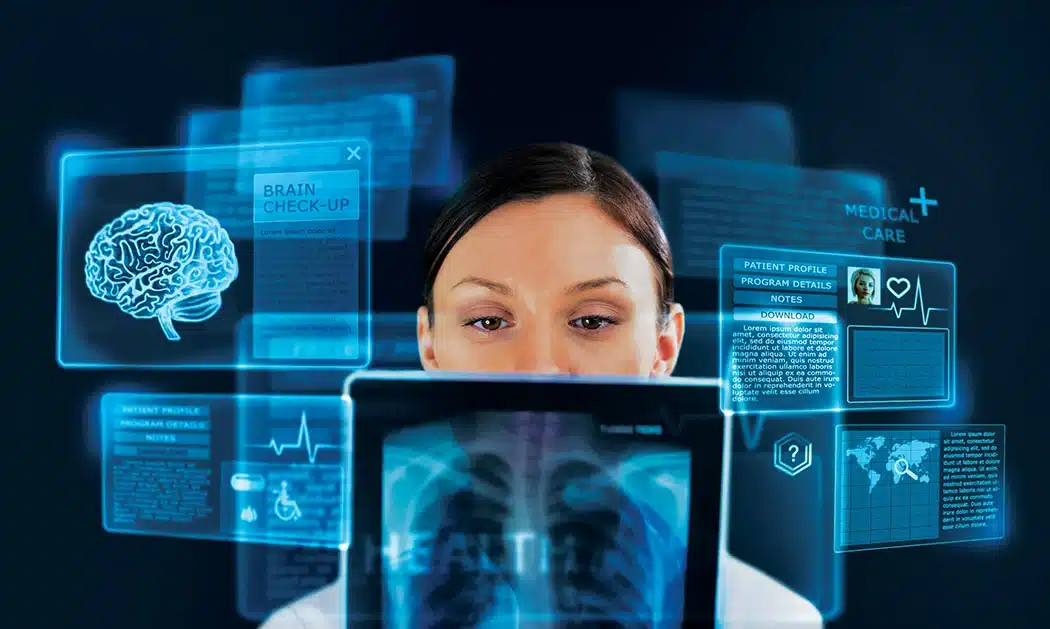Technology is changing our lives fast, and healthcare is at the forefront of this change. Teleradiology is a key part of this change, making it easier to share and read medical images like X-rays and MRIs from anywhere. This means doctors can look at your scans and give you a diagnosis faster, no matter where you are.
This new way of doing things is making healthcare better for everyone. It’s opening up new ways to get medical help, especially in places where it was hard to get before. The more people use teleradiology, the more it changes how we think about healthcare.
Key Takeaways
- Teleradiology lets doctors look at medical images from anywhere, breaking down distance barriers.
- This tech speeds up getting a diagnosis and helps doctors work together better.
- The teleradiology market is growing fast, changing healthcare for the better around the world.
- Patients get their diagnoses quicker and receive better care thanks to teleradiology.
- Teleradiologists are key in telemedicine, bringing their expertise and quality checks to the table.
Understanding Teleradiology: Bridging Gaps, Enhancing Care
Teleradiology is changing how we get medical help around the world. It solves the problem of not having access to special medical services. This tech lets doctors send and read medical images like MRI and X-rays over the internet. This helps people in far-off places get the care they need faster.
This tech lets doctors look at medical images from anywhere. It’s a big step forward for healthcare, especially in places that didn’t have access to these services before.
Fostering Collaborative Care
Teleradiology makes getting a diagnosis quicker and helps doctors work together better. Doctors can talk to experts in other places for advice. This teamwork makes care better because doctors use everyone’s skills, no matter where they are.
| Teleradiology Benefits | Description |
|---|---|
| Improved Healthcare Accessibility | Teleradiology bridges geographical barriers, enabling access to specialized radiology services in underserved or remote areas. |
| Accelerated Diagnosis | The remote transmission and interpretation of diagnostic images speed up the diagnostic process, leading to faster treatment and improved patient outcomes. |
| Collaborative Care | Teleradiology fosters a collaborative approach to patient care, allowing healthcare providers to consult with remote radiologists and leverage their specialized expertise. |
Teleradiology is changing how we get top-notch medical imaging services worldwide. It’s making sure everyone can get the care they need, no matter where they are.
Teleradiology: A Rapidly Growing Market

The teleradiology market is set to grow a lot in the next few years. Experts say it will grow by 25.5% each year from 2024 to 2034. By 2034, it’s expected to be worth a huge USD 87.94 Billion. Several factors are driving this growth. New medical technology, the need for quick diagnoses, and not enough doctors in some areas are key reasons. These factors are making teleradiology more important.
Teleradiology helps overcome distance and gives people access to expert medical care from anywhere. As people want better and easier healthcare, teleradiology is becoming key. It helps patients and healthcare providers meet their needs.
| Metric | Value |
|---|---|
| Teleradiology Market Size (2024) | USD 14.69 Billion |
| Teleradiology Market Size (2034) | USD 87.94 Billion |
| Compound Annual Growth Rate (2024-2034) | 25.5% |
The fast growth of teleradiology shows how medical technology is changing healthcare. As telemedicine trends evolve, teleradiology is key to a fair and efficient healthcare system.
Teleradiology Benefits Patients: Faster Diagnosis, Improved Care
Teleradiology is changing healthcare by letting doctors look at medical images from anywhere. This technology helps patients by making diagnosis faster and care better. It also makes healthcare services more accessible.
One big plus of teleradiology is faster diagnosis. Patients don’t have to wait a long time to get their test results. Teleradiologists can look at images quickly, often in minutes or hours. This means patients can get the treatment they need faster, which can lead to better health outcomes and reducing healthcare costs.
Teleradiology also makes sure more people can get the care they need. Even if you live in a small town or a place far from big cities, you can get top-notch medical care. This is because teleradiologists can work from anywhere. So, everyone gets the best diagnostic imaging and care, which helps make treatment decisions better and improves patient care.
Working together is another way teleradiology changes healthcare. Doctors can talk and work with other health experts to help patients. This teamwork leads to better diagnoses and treatments, making care better for everyone.
There are also cost savings for patients and healthcare providers. With teleradiology, people don’t have to travel far for tests, and waiting times go down. This makes healthcare more efficient and saves money for everyone.
“Teleradiology has revolutionized the way we deliver healthcare, empowering patients to receive timely, high-quality diagnostic imaging services no matter their location.”
In summary, teleradiology is changing healthcare for the better. It gives patients faster diagnoses, better access to experts, and helps doctors work together. As this technology grows, it will keep making healthcare better for patients.
| Teleradiology Benefit | Impact |
|---|---|
| Faster Diagnosis | Quicker treatment and improved patient outcomes |
| Improved Healthcare Access | Increased access to specialized radiological expertise, even in remote or underserved areas |
| Enhanced Collaborative Care | Allows radiologists to work closely with other medical professionals for comprehensive patient care |
| Cost Savings | Reduced patient travel, minimized waiting times, and optimized resource utilization |
The Role of Teleradiologists

Teleradiologists are key in telemedicine and healthcare. They look at medical images from afar and give quick reports. They work with healthcare teams, make sure quality is high, and offer their expertise in many radiology areas.
They mainly look at medical images like X-rays and MRI scans from a distance. Using telemedicine tech, they can check these images and send their findings to doctors fast.
Teleradiologists also work with healthcare teams on the ground. They share their knowledge to improve patient care. They make sure the diagnosis is accurate by following strict rules and using their radiology skills.
Also, teleradiologists know a lot about certain radiology areas, like brain or bone imaging. This lets them give full remote imaging interpretation services. They meet the different needs of healthcare providers and patients.
“Teleradiologists play a vital role in delivering efficient and high-quality healthcare services through the teleradiology platform.”
Thanks to telemedicine, teleradiologists are changing healthcare. They make sure patients get the expert care they need, no matter where they are.
Teleradiology

Teleradiology is changing healthcare around the world. It breaks down barriers, making sure everyone gets the same quality care. This new way of doing things is making healthcare better and more accessible for everyone.
Teleradiology is leading the way in healthcare. It helps solve problems like not having enough resources or experts. By using technology to share medical images, doctors can work together across distances. This leads to faster and more accurate diagnoses, which helps patients all over the world.
The teleradiology market is growing fast. This shows how much people value its benefits. As technology gets better, teleradiology will keep making healthcare better. It will make things run smoother and help doctors work together across borders.
By using teleradiology, healthcare can reach more people, no matter where they are. This shows how technology can improve health care. Teleradiology is changing healthcare for the better, making sure everyone can get the care they need.
| Key Benefits of Teleradiology | Impact on Healthcare |
|---|---|
|
|
“Teleradiology is revolutionizing the way we approach healthcare, breaking down geographical barriers and democratizing access to quality diagnostic services. This medical technology is not just a tool, but a catalyst for transforming the future of global healthcare.”
Embracing the Future of Teleradiology
The healthcare world is always changing, and teleradiology will play a big part in this change. By using this technology, healthcare can do more with less. It opens up new ways to work together and give patients the best care possible.
Also Read : How Long Does It Take To Recover From Major Surgery?
Conclusion
Teleradiology is changing the way we get medical images and care around the world. It connects people across distances, making it faster to diagnose diseases. This technology is making healthcare better by working together more effectively.
The teleradiology market is growing fast, showing its huge potential. It can make healthcare more accessible and improve patient care. With new tech like artificial intelligence, teleradiology is set to change healthcare for the better.
Teleradiology makes getting medical images and advice easier and faster. It’s key in today’s healthcare world. As we need better healthcare more, teleradiology will play a big part in the future. It will lead to better patient care and more access to medical experts.
FAQs
Q: What is teleradiology and how does it work?
A: Teleradiology is the transmission of radiological images over electronic networks for interpretation by radiologists. This allows for remote analysis of imaging studies such as CT scans, MRIs, and X-rays, enabling healthcare providers to access expert opinions regardless of geographical barriers.
Q: What are the benefits of teleradiology?
A: The benefits of teleradiology include improved access to radiology services, especially in rural areas, faster turnaround times for diagnostic imaging reports, and the ability to obtain second opinions from subspecialty radiologists. It enhances patient care by ensuring timely and accurate diagnoses.
Q: How does teleradiology improve turnaround time for imaging services?
A: Teleradiology systems allow radiologists to work remotely and access images instantly, which significantly reduces the turnaround time for radiology reports. This means that healthcare providers can receive final reports more quickly, facilitating prompt patient management.
Q: Are there any regulations governing teleradiology services?
A: Yes, teleradiology services must adhere to regulations such as the Health Insurance Portability and Accountability Act (HIPAA) to ensure patient confidentiality and data security. Additionally, radiology practices may seek accreditation from organizations like the American College of Radiology (ACR) to validate their quality and compliance.
Q: What types of imaging can be transmitted through teleradiology?
A: Various types of imaging modalities can be transmitted through teleradiology, including but not limited to CT scans, mammography, and musculoskeletal imaging. This broad range allows for diverse diagnostic services across multiple subspecialties.
Q: How does international teleradiology benefit global healthcare?
A: International teleradiology enables healthcare facilities worldwide to access specialized radiology services, overcoming local shortages of radiologists. This collaboration enhances global healthcare by providing expert diagnostic imaging interpretation in underserved regions.
Q: Can teleradiology provide services for emergency departments?
A: Yes, teleradiology can greatly benefit emergency departments by facilitating immediate access to radiology services. This allows on-call radiologists to provide rapid interpretations of critical imaging studies, improving patient outcomes in emergency situations.
Q: How do teleradiology systems ensure the quality of radiology reports?
A: Teleradiology systems utilize DICOM standards for image transmission and maintain rigorous quality control measures. Radiologists are often board-certified and may have subspecialty training, ensuring that the reports generated meet high professional standards.
Q: What is the role of radiology groups in teleradiology?
A: Radiology groups play a crucial role in teleradiology by coordinating the provision of services, managing the workflow of radiologists, and ensuring compliance with accreditation standards. They facilitate collaboration among radiologists and streamline the interpretation process for imaging studies.





